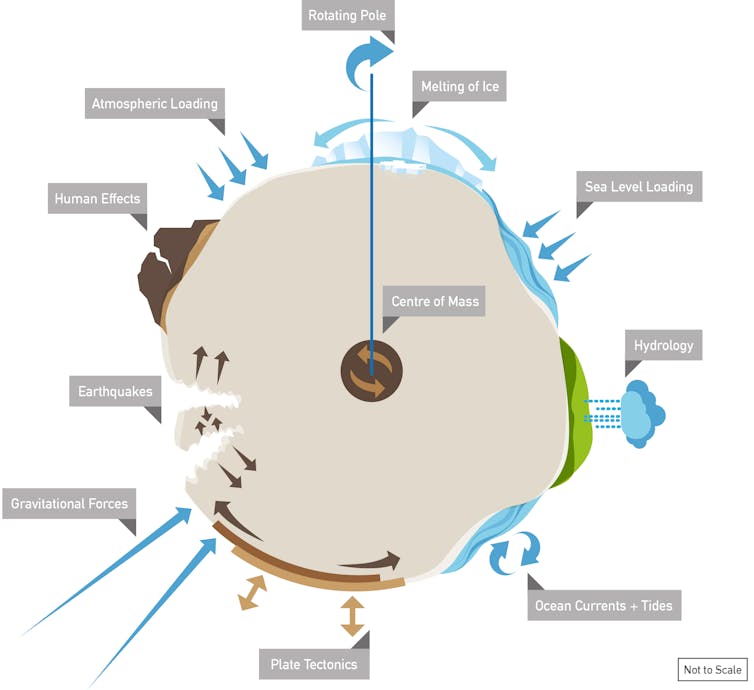Melting ice and satellites: how to measure the Earth's 'wiggle'
- Written by Anna Riddell, Geodesy PhD Candidate, University of Tasmania
In a driverless future, it will be vital that our cars know exactly where they are on the road, down to the millimetre. We’ve found that our current methods of measuring location may not be up to scratch. Changes on Earth’s surface, including polar ice melt, may alter its centre of mass, throwing our calculations out of whack.
Accurately pinpointing a location with a global positioning system (GPS) can only be done relative to Earth’s centre. Because we can’t reach the centre ourselves, scientists have to use satellite sensing to indirectly measure its location, and how it moves.
It’s a complicated task because the globe is not a perfect sphere nor uniformly made of the same material. Significant changes on its surface, such as melting snowpack, may also shift its centre of mass.
This means the centre of Earth essentially “wiggles”, but current measurement methods don’t accurately measure season-to-season variations that occur due to water movement. They also assume that its long-term motion can be described by the fit of a straight line. We believe that much more work needs to be done.
The centre of the Earth is on the move
The centre of Earth’s mass may not necessarily be close to its geometric centre.
To put it another way, while a cannonball’s centre of mass will be at its exact geometric centre, a pineapple’s centre of mass is closer to its heavier end.
It’s the same for Earth’s centre of mass: it will be closer to heavier loads on the surface and within Earth itself.
 Processes that cause the surface of the Earth to deform at decadal scales.
Anna Riddell, Author provided
Processes that cause the surface of the Earth to deform at decadal scales.
Anna Riddell, Author provided
Water can be a “heavier load”, both in the oceans, rivers and atmosphere, and in its solid form as ice sheets, glaciers and snow. High water levels in the Northern Hemisphere due to massive snowfall and rain over Canada and Europe during the winter, for example, change as the seasons transition into summer.
This matters when measuring Earth’s centre of mass. Take a ridiculously heavy cyclist, for example. As the cyclist travels over the surface of the Earth, the centre of Earth’s mass moves, as a balancing act. In the same way, as snow melts in the Northern Hemisphere spring and flows into the oceans, the Earth’s centre of mass may move away from the Northern Hemisphere.
 A hypothetical (and very heavy) cyclist moving over the surface of the Earth will cause motion of the centre of the Earth.
Roelof Rietbroek, Author provided (restricted)
A hypothetical (and very heavy) cyclist moving over the surface of the Earth will cause motion of the centre of the Earth.
Roelof Rietbroek, Author provided (restricted)
As we monitor changes to land ice in Antarctica and Greenland, as well as the smaller mountain glaciers, we can also see changes in the motion of Earth’s centre of mass.
As some of this ice melt is due to human activity warming the atmosphere and ocean, humans may be indirectly changing the centre of mass of the entire planet.
How we find the centre
The centre of Earth has historically been measured by shooting powerful lasers to reflective satellites in orbit. By tracking these small “golf ball” satellites, we can estimate Earth’s centre of mass and its small variations.
The movement of Earth’s centre of mass can also be estimated by tracking changes in gravity, as sensed by twin satellites chasing each other called the Gravity Recovery and Climate Experiment (GRACE).
 NASA’s fleet of 18 Earth science missions in space, including GRACE.
NASA, CC BY
NASA’s fleet of 18 Earth science missions in space, including GRACE.
NASA, CC BY
We found that the two approaches, both the “golf ball” satellites and models with GRACE data, show movement of a few millimetres of Earth’s centre of mass. This is due to seasonal snowfall, but also the result of longer-term changes occurring because of increased ice melt and movements within planet itself, such as shifts in Earth’s mantle.
The two approaches also show differences in the amount and style of movement, which suggest that we cannot yet be totally confident we really know where the centre of mass is and how it is moving.
Our research also estimates that the long-term motion of Earth’s centre of mass has a banana-like bend rather than travelling in a straight line, but it’s not yet clear if that’s real or not.
As we gather more information and the demand for GPS exactness increases, our assumptions about how the centre is measured will need to change.
Why we need to know where we’re going
Because GPS measures relative to the centre of mass, any uncertainty in our knowledge of where the centre of Earth is and how it moves reduces its accuracy.
Improvements will come through more careful interpretation of satellite laser ranging measurements and long-term, stable funding of these global observatories, including those in Australia.
But improved knowledge of the location of the centre of Earth is just one part of ongoing efforts to improve the accuracy of our positioning. We also need to keep track of the tectonic movement of Australia, for example. Even distant earthquakes can change the shape of the land by amounts that matter.
If we’re to know exactly where we are, our methods for measuring Earth’s centre need an overhaul.
Authors: Anna Riddell, Geodesy PhD Candidate, University of Tasmania
Read more http://theconversation.com/melting-ice-and-satellites-how-to-measure-the-earths-wiggle-77799





